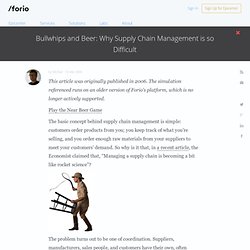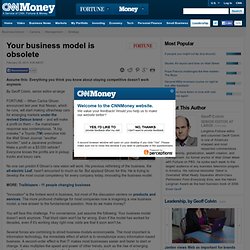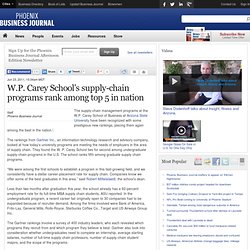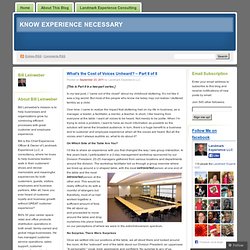

Benchmark study compares forecasting performance results « Supply Chain Movement. In 2010, the volume of promotions was 77 per cent greater than in 2009 – that is just one of the findings from the extensive forecasting benchmark study conducted by Terra Technology amongst manufacturers and suppliers in the consumer goods sector.

Rather than wait for the supply-chain solutions provider to officially present its findings in late June 2011, Supply Chain Movement met up with Terra Technology’s CEO, Robert Byrne, on 14 June 2011 during the Supply Chain Logistics Europe event in Berlin (Germany). The study, which included input from the likes of Procter & Gamble, Unilever, Kraft Foods, Kimberly Clark and Campbell Soup, provides insights into the forecasting performance of organisations within the consumer products industry. According to Byrne, it is the only study where the results are truly comparable across all companies. A forecast error of between 45 and 50 per cent is often meaningless because it depends on how it has been measured. Bullwhips and Beer: Why Supply Chain Management is so Difficult « Forio Business Simulations. This article was originally published in 2006.

The simulation referenced runs on an older version of Forio’s platform, which is no longer actively supported. Play the Near Beer Game The basic concept behind supply chain management is simple: customers order products from you; you keep track of what you’re selling, and you order enough raw materials from your suppliers to meet your customers’ demand. So why is it that, in a recent article, the Economist claimed that, “Managing a supply chain is becoming a bit like rocket science”? The problem turns out to be one of coordination. This lack of coordination coupled with the ability to influence while being influenced by others leads to what Stanford’s Hau Lee refers to as the Bullwhip Effect.
Why corporate giants fail to change. By Julian Birkinshaw (TheMIX) -- Last week, I taught a case study on the decline of Nokia to my MBA students.

I asked them, "Why did Nokia fall from industry leadership to also-ran status in the space of less than five years? " Their answers were predictable: "They lost touch with their customers. " True, but almost tautological -- and interesting to note that this is the same Nokia that in the early 2000s was lauded for its customer-centric marketing and design capabilities. " Through this period, the people at Nokia were aware of the changes going on around them, and they were never short of leading-edge technology or clever marketers. The failure of big companies to adapt to changing circumstances is one of the fundamental puzzles in the world of business.
In such cases, the ultimate responsibility for failure rests with the CEO. Why the 'most innovative companies' aren't. By Jeff DeGraff (TheMIX) -- Pull out the list of the "most innovative companies" from your favorite business magazine.

With the exception of their brand recognition, which is the entry fee for these beauty pageants, they have few innovation practices in common that would distinguish them from the rest of the rabble, whether it's unique strategies, unusual financing, or novel ways of hiring and staffing. The fact is that one size never fits all. What makes innovation companies unique is, well, unique. They are highly adapted for their specific situation. How Great Businesses Keep Surviving and Thriving. Your business model is obsolete. By Geoff Colvin, senior editor-at-large FORTUNE -- When Carlos Ghosn announced last year that Nissan, which he runs, will start making ultracheap cars for emerging markets under the revived Datsun brand -- and will make a profit on them -- the mainstream response was contemptuous.

"A big mistake," a Toyota (TM) executive told the Wall Street Journal; "another blunder," said a Japanese professor. Make a profit on a $3,000 vehicle? Everyone knows the profits are in pickup trucks and luxury cars. Why Big Companies Can't Innovate - Maxwell Wessel. By Maxwell Wessel | 8:00 AM September 27, 2012 Big companies are really bad at innovation because they’re designed to be bad at innovation.

Take a story plucked from the pages of Gerber’s history. In 1974, the company’s growth potential was waning. In order to grow profitability and fight margin pressure, Gerber executives turned towards a market they hadn’t successfully penetrated for decades: adult food. It's Time to Rethink Continuous Improvement - Ron Ashkenas. Apple's Supply-Chain Secret? Hoard Lasers. About five years ago, Apple (AAPL) design guru Jony Ive decided he wanted a new feature for the next MacBook: a small dot of green light above the screen, shining through the computer’s aluminum casing to indicate when its camera was on.

The problem? It’s physically impossible to shine light through metal. Ive called in a team of manufacturing and materials experts to figure out how to make the impossible possible, according to a former employee familiar with the development who requested anonymity to avoid irking Apple. The team discovered it could use a customized laser to poke holes in the aluminum small enough to be nearly invisible to the human eye but big enough to let light through. Applying that solution at massive volume was a different matter. Most of Apple’s customers have probably never given that green light a second thought, but its creation speaks to a massive competitive advantage for Apple: Operations.
Apple details supply chain in responsibility report. Apple's supply chain is one of the more closely guarded secrets in the tech world; even simply confirming you have the Cupertino company in your order book has been enough to see some companies lose contracts.

However Apple itself has spilled the beans on the rolodex it flips through when it needs a new iPhone screen or iPad radio, detailing the firms [pdf link] which together account for 97-percent of procurement expenditures for materials, manufacturing and assembly of products worldwide. The disclosure is part of Apple's annual Supplier Responsibility Program, with the company releasing today its progress report for 2011. Apparently supply chain 229 audits took place last year - 80-percent more than in 2010 - and 100 of which were first-time investigations. These also included new environmental checks, focused on specific Chinese suppliers, working alongside independent engineering experts to look into 14 facilities.
The full progress report can be read here [pdf link]. Supplier Responsibility. Amazon Should Partner with Independent Bookstores - Sarah Green - Our Editors. China Makes Almost Nothing Out of Apple's iPads and iPhones. W.P. Carey School’s supply-chain programs rank among top 5 in nation. Staff Phoenix Business Journal The supply-chain management programs at the W.P.

Carey School of Business at Arizona State University have been recognized with some prestigious new rankings, placing them again among the best in the nation. What’s the Cost of Voices Unheard? – Part II of II « Know Experience Necessary. [This is Part II in a two-part series.]

In my last post, I “came out of the closet” about my childhood stuttering. It’s not like it was a big secret. But most of the people who know me today may not realize I stuttered terribly as a child. Over time, I came to realize the impact that stuttering had on my life in business, as a manager, a leader, a facilitator, a mentor, a teacher. In short, I like hearing from everyone at the table. Change Is Hardest in the Middle - Rosabeth Moss Kanter. By Rosabeth Moss Kanter | 5:13 PM August 12, 2009 It’s no surprise that moods are sagging in mid-2009. The capital markets are stalling, the banks are barely lending, the federal government stimulus is not stimulating enough, and job losses are mounting. Incumbent politicians promise that things are getting better, but not in your city, where the powers-that-be are shutting down the zoo and raising public transportation fares, making subway rides so expensive that cars still clog the roads.
Even optimists feel anxiety. Perhaps you are a visionary leader, intrepid innovator, or enthusiastic entrepreneur determined to make the best of it, recession or not. Welcome to the miserable middles of change. Transportation Forecasting based on actual data « Supply Chain Movement. During Logicon on 3rd February 2011, in Amsterdam, Terra Technology – not to be confused with Teradata – presented its newest solution to the European market: Transportation Forecasting. “Most transportation management solutions are based on historical data. Our transportation forecasting tool focuses on what’s going on now”, comments Robert Byrne, CEO of Terra Technology.
Terra’s Transportation Forecasting has been designed specifically for producers of consumer goods. Promotions are visible in advance and it creates the opportunity for proactive transportation planning and reserving capacity as needed, rather than waiting until orders arrive. When asked whether or not they feel like the new kids on the block when it comes to supply chain solutions, the CEO with his MBA in Operations Research laughed and commented: “I suppose we are!
Procter & Gamble, Unilever, Kraft Foods and Campbell’s Soup are just a few of Terra Technology’s clients. www.terratechnology.com. Visibility of complexity « Supply Chain Movement. According to Professor David Simchi-Levi from MIT in Boston, there are six trends that are challenging current thinking on supply chain management: globalisation, the increasing cost of logistics, higher levels of risk in the chain, increasing cost of labour in developing countries, the focus on sustainability and the fluctuation of the cost of raw materials. One important thing that these six trends imply is the need for transparency in the supply chain. Simchi-Levi sees three different levels of transparency: where my products are in the chain, having access to the suppliers’ production schedules and track & trace using sensors on the products, pallets or packaging. Supply Chain and Finance share the same vision « Supply Chain Movement.
In most Dutch enterprises’ supply chains, there is some kind of relationship between corporate strategy and inventory level targets. The supply chain and finance departments generally tend to agree on who should be determining optimum stock levels. Yet while these two departments consult regularly on this matter within most companies, only forty percent of them have formalised this in a Sales & Operations Planning (S&OP) process. Such are the most significant conclusions from a study of S&OP implementation among a total of 82 supply-chain and finance professionals in The Netherlands, which was initiated by S&V Management Consultants and ConQuaestor in collaboration with Supply Chain Movement magazine.
The research has provided valuable insights into how both finance and supply chain departments view working capital management in relation to S&OP. The Fresh Connection AU - TFC News. Supply Chain Movement Group News. Importance of Packaging Innovation to Supply Chains. I recently interviewed Michael Rada who discussed the realization of supply chain optimization through innovative packaging. Michael Rada works for the third largest corporation of Japan. He lives in Czech Republic and works Sumisho Global Logistics Europe, which is a bit unusual. He considers himself to be more Asian than European. He studied Japanese for almost 30 years. He works as a manager with a wide range of responsibilities. One of Sumisho Global Logistics’ achievements is in their packaging. They are currently concentrating on electronics manufacturers, which is one of their major clients.
Packaging is one of the big issues they address. - Demand for sustainable and green packaging ramps up. Designing supply chain Processes and Organizations. 50 page presentation focusing on SCOR. - Aerospace and defence sector faces supply chain 'big squeeze' - Poor supplier management can lead to 'catastrophic' failure. - Hershey accused of using child labour in cocoa supply chain. - Bad planning hampers procurement outsourcing projects. Why Manufacturing Should be Done in the US. I recently interviewed Mark Munson who discussed why manufacturing should be done in the US. Why should manufacturing be done in the US? Manufacturing is really an industry which has been in decline in the US, but it is something as a country we should not allow.
This industry is key to the security and national stability of our nation, which we have seen over the recent recession. Even with the decline manufacturing is the key driver to the economies in most states. A Sparkle of Optimism: Cities with Salary Growth. Social Supply Chain as a sub-set of the Social Enterprise. Procurement, have you looked in the rear-view mirror? - Procurement Intelligence Unit. Small and large suppliers embracing collaboration key to America's supply chain dynamism. - Rising fuel prices and commodity shortages hit US supply chains.
Supply chain risk management and creating innovation in the supply chain. E-newsletter Sample. Needed innovation in Lean Concepts. - Analysis: Procurement outsourcing goes beyond cash. Supply Chain Movement Group News. Supply Chain Re-Invention Falls Sway to Optimization. I recently interviewed Graham Roper. What is the next step for ERP technology? Economic aftershocks of the earthquake: lean needs resilience - Procurement Intelligence Unit.
Small Supplier Innovation with Large Firms. How to make America’s Supply Chains more dynamic and innovative. - Global sourcing gets Jaguar Land Rover on track. Don't save costs, add value - Procurement Intelligence Unit. Supply Chain Value Network Analysis. I recently interviewed David Meggitt, a Value Network Analysis practitioner who discussed what he does and how it can be applied to supply chains. - Corporate procurement pros facing 'serious challenges' - Kraft Foods aims to boost supply chain sustainability. - Counterfeiting in global supply chain costs US companies $250bn. How do you put a price tag on green products? - Procurement Intelligence Unit. Social Media Use in Small and Large Organizations. Building a Learning Organization.
I recently had an email interview with Dr. Wayne Guppy Ed.D. - Supply chain issues threaten US technology industry. You’re Through the Door, Now Stay Inside - Sales- Eventbrite. Procurement GPS: Supply Base Management - procurement as the architect of supply - Procurement Intelligence Unit. Biggest Supply Chain Risk of 21st Century. - Malaysian oil and gas company takes procurement into the cloud. European supply chain software mapped out « Supply Chain Movement. - Supply chain efficiency 'critical' to global consumer companies. Where does your iPhone come from? - Procurement Intelligence Unit.
Identifying RFID's Biggest Threats. Lean Supply Chains: How to Lean, Agile, and “Leagile” Supply Chain Strategies Compare? Rebuilding Supply Chains for the Future. RFID Journal - RFID (Radio Frequency Identification) Technology News & Features.